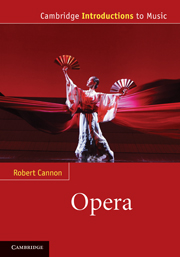Book contents
- Frontmatter
- Contents
- Tables
- Introduction
- Part I The seventeenth and eighteenth centuries
- Part II The nineteenth century
- Part III The twentieth and twenty-first centuries
- Chapter 13 The turn of the century and the crisis in opera
- Chapter 14 First modernism: Symbolist and Expressionist opera
- Chapter 15 The dramaturgy of opera: libretto – words and structures
- Chapter 16 Narrative opera: realistic and non-realistic
- Chapter 17 Radical narratives
- Chapter 18 Directors and the direction of opera
- Appendix 1 Motifs from The Ring used in Chapter 10
- Appendix 2 The development of singing voices in opera
- Appendix 3 The development of lyric theatre alternatives to ‘opera’
- Appendix 4 Some major operas and artistic and political events of the twentieth century, 1899--2008
- Glossary of key terms
- Notes
- Bibliography
- Index
Chapter 17 - Radical narratives
from Part III - The twentieth and twenty-first centuries
Published online by Cambridge University Press: 05 June 2012
- Frontmatter
- Contents
- Tables
- Introduction
- Part I The seventeenth and eighteenth centuries
- Part II The nineteenth century
- Part III The twentieth and twenty-first centuries
- Chapter 13 The turn of the century and the crisis in opera
- Chapter 14 First modernism: Symbolist and Expressionist opera
- Chapter 15 The dramaturgy of opera: libretto – words and structures
- Chapter 16 Narrative opera: realistic and non-realistic
- Chapter 17 Radical narratives
- Chapter 18 Directors and the direction of opera
- Appendix 1 Motifs from The Ring used in Chapter 10
- Appendix 2 The development of singing voices in opera
- Appendix 3 The development of lyric theatre alternatives to ‘opera’
- Appendix 4 Some major operas and artistic and political events of the twentieth century, 1899--2008
- Glossary of key terms
- Notes
- Bibliography
- Index
Summary
In the first years of the twentieth century dramatists began looking for alternatives to the ‘hermetic’ drama, whether Naturalistic, Realistic, or Symbolist. Each of these was designed to draw the audience into an empathetic relationship with situations and characters so that they saw them and their dilemmas as inevitable and unchangeable. As Brecht wrote: ‘We would not wish to create the illusion of reality…Were one to create such an illusion that is all it would remain, and the audience would only see and consider it as such. Were the reality of life simply imitated then there would be nothing more to see or feel than in life itself. Which is not enough’ (Brecht, 1948: 38). What was needed was a dramaturgy that allowed the audience to understand that in every case a choice had been made and that there were alternatives. Brecht's aesthetic and dramaturgy were derived from Marxist dialectics and worked at two inter-locking levels:
The audience had to be enabled to read each action and decision as part of a man-made situation that was neither natural nor inevitable.
Each aspect of the action and its staging had to be made part of this process by declaring its own mechanism.
For Brecht this was part of a larger, Marxist, politic. But this kind of staging and dramatic theory produced a range of other applications. It allowed composers to separate out the different elements of which an opera was made so that coherence took place in the audience's consciousness. This shift is a hallmark of much late twentieth- and twenty-first-century opera (Table 17.1).
- Type
- Chapter
- Information
- Opera , pp. 357 - 379Publisher: Cambridge University PressPrint publication year: 2012

